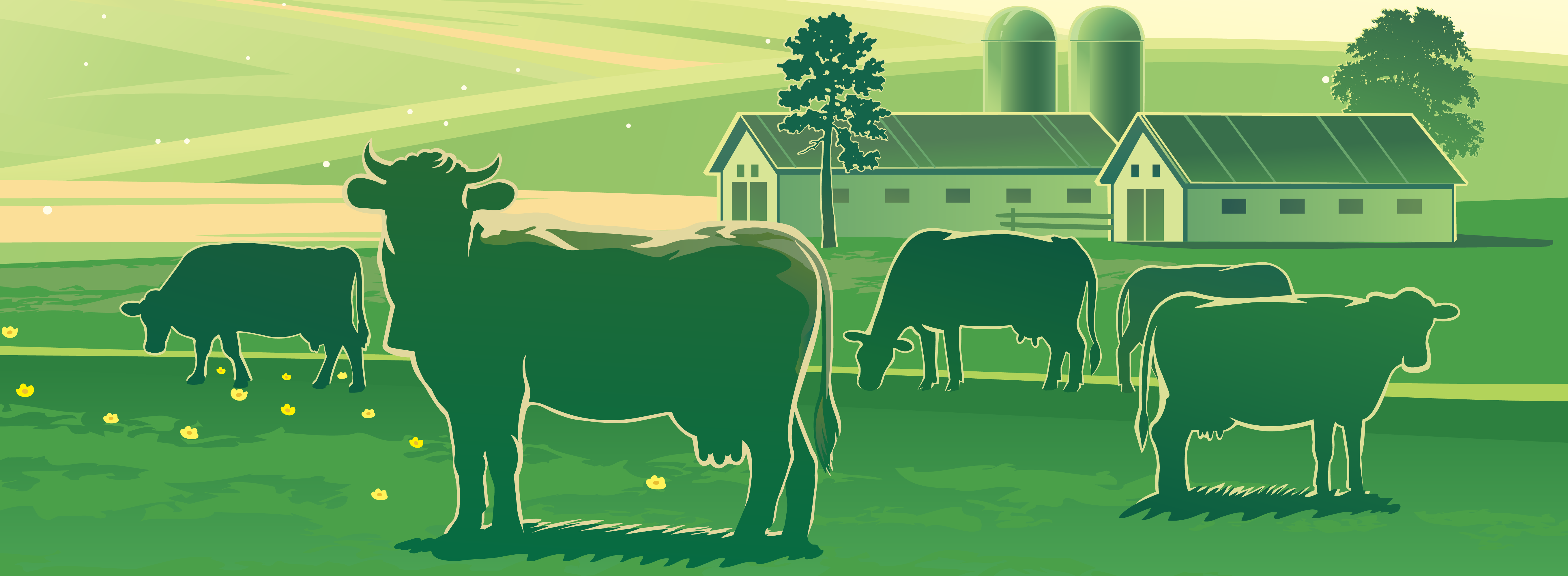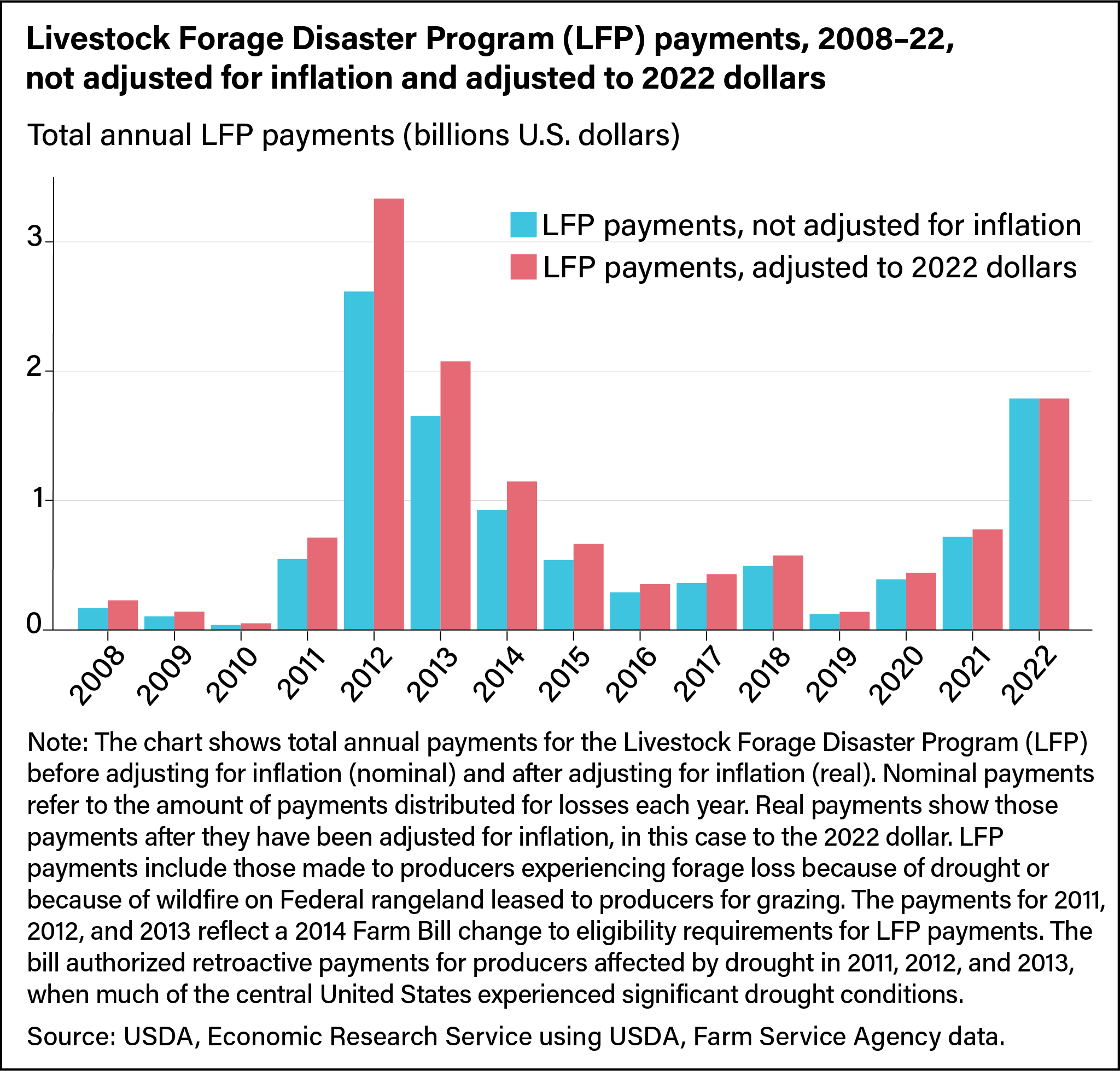
As Drought Threats Continue, Government’s Financial-Climate Risk From Livestock Forage Disaster Program Expected To Increase
- by R. Aaron Hrozencik
- 8/8/2024
Highlights
- Payments to livestock producers under the Livestock Forage Disaster Program may increase with more frequent and severe drought conditions.
- Modeling results indicate that Federal Government spending on the program will increase 45 percent (in 2022 dollars) by 2100 for moderate greenhouse gas emissions scenarios and 65 percent for middle-of-the-road emissions scenarios.
- Under high and accelerating emissions scenarios, Federal spending on the program will increase by more than 100 percent (in 2022 dollars) by 2100 compared with average expenditures between 2014 and 2022.
Drought is a persistent threat to the U.S. agricultural sector, including livestock producers who rely on precipitation to grow forage used to feed their herds. During severe and persistent drought conditions livestock producers must decide whether to buy forage to feed their herds or to reduce their herd size. For instance, the national beef herd size of roughly 25 million head shrank about 1 to 2 percent a year during drought between 2011 and 2015.
USDA administers several programs to mitigate the economic costs of drought. Among these programs is the USDA, Farm Service Agency’s (FSA) Livestock Forage Disaster Program, which provides payments to livestock producers impacted by drought. Various types of livestock are eligible for the program ranging from more traditional livestock such as beef and dairy cattle to more exotic types of livestock such as reindeer and ostriches. FSA annually sets species-specific payment rates to cover about 60 percent of monthly feed and forage costs.
To be eligible for program payments, the county in which a livestock producer operates must experience drought conditions that exceed a given threshold. County-level drought conditions are classified weekly by U.S. Drought Monitor, which assigns five levels of increasing drought severity: “D0: Abnormally Dry,” “D1: Moderate Drought,” “D2: Severe Drought,” “D3: Extreme Drought,” and “D4: Exceptional Drought.” Livestock producers become eligible for 1 month of Livestock Forage Disaster Program payments when the county where they operate experiences 8 consecutive weeks of “severe drought.” Livestock producers become eligible for additional months of payments when experiencing more than severe drought conditions. For example, a livestock producer operating in a county experiencing four weeks of “exceptional drought” is eligible for 5 months of payments through the program.
The Livestock Forage Disaster Program was authorized in the 2008 Farm Bill, which funded the program through 2011 and included an eligibility requirement that producers purchase a risk management product. The program was suspended after 2011 until passage of the 2014 Farm Bill, which allowed for retroactive payments to producers who had experienced drought-related losses in 2011, 2012, and 2013. The 2014 Farm Bill also altered eligibility criteria for the program, striking the previous risk management purchase requirement. Periods with more severe drought conditions in livestock-producing regions are associated with higher total annual program payments. For example, annual payments through the program peaked in 2012 to more than $3 billion (in 2022 dollars) when many of the United States’ most productive livestock-producing regions experienced severe drought conditions.
The Financial-Climate Risk of the Livestock Forage Disaster Program
U.S. climate projections suggest drought conditions may become more frequent and intense, underscoring the potential importance of the program but also raising questions regarding future Government spending on the program. ERS modeling indicates the program may constitute a climate-related financial risk for the Federal Government budget, meaning that the Government could face a risk of increased expenditures or reduced revenues because of climate change. The modeling shows that if greenhouse gas emissions remain high (scenario III with the temperature increase of below 4 degrees Fahrenheit from the current level), then annual average program payments may increase more than 100 percent by the 2070–2100 period.
Analyzing the financial-climate risk of the Livestock Forage Disaster Program involves estimating how differing levels of drought severity translate into payments and then simulating future payments based on projections of future drought conditions. Researchers with USDA, Economic Research Service used data on annual county-level program payments and U.S. Drought Monitor drought classifications from 2014 to 2022 to model the relationship between drought severity and program payments. Next, they projected future county-level U.S. Drought Monitor drought classifications through 2100 using information from eight climate projection models. Finally, they paired the model’s estimates of how county-level payments relate to different drought severity levels with future drought classifications to simulate future program payments. This analysis also used a range of greenhouse gas emissions scenarios to project different levels of drought conditions and Federal Government program spending.
Modeling Results
Projections of future Livestock Forage Disaster Program payments are based on four greenhouse gas emissions scenarios, defined by the Intergovernmental Panel on Climate Change and covering a range of warming levels from low to high.
| Greenhouse gas emissions scenario | Expected temperature increase (in Celsius) by 2100 | Projected increase in annual average program spending from 2014–2022 to 2070–2100 (2022 U.S. dollars) | Projected percent increase in annual average program spending from 2014–2022 to 2070–2100 |
| Scenario I: Moderating emissions | Less than 2 degrees | $300 million | 45 percent |
| Scenario II: Middle-of-the-road emissions | Less than 3 degrees | $450 million | 65 percent |
| Scenario III: High emissions | Less than 4 degrees | $800 million | 113 percent |
| Scenario IV: Accelerating emissions | Greater than 4 degrees | $950 million | 137 percent |
| Note: Greenhouse gas emissions scenarios are defined by the Intergovernmental Panel on Climate Change and defined to encompass a range of future warming levels. Projected increases in Livestock Forage Disaster Program expenditures are estimated using output from an econometric model relating observed county-level LFP payments to drought severity paired with climate model output simulating future drought conditions under differing greenhouse gas emissions scenarios. Average annual spending on the program spending from 2014 and 2022 was $700 million. Source: USDA, Economic Research Service (ERS) using data from USDA, Farm Service Agency. | |||
In scenarios I (moderating emissions) and II (middle-of-the-road emissions), average annual payments through the Livestock Forage Disaster Program over a period ranging from 2070 to 2100 are projected to increase by about $300 million (2022 dollars) and $450 million (2022 dollars), respectively, compared with the 2014–22 average. These dollar changes translate into an increase of about 45 percent for scenario I and 65 percent for scenario II.
In scenarios III and IV, with high and accelerating greenhouse gas emissions, average annual payments for the program during the 2070–2100 period will increase by $800 million (2022 dollars) and $950 million (2022 dollars), respectively, compared with the 2014–2022 average. That would represent increases of about 113 percent under the high emissions scenario and 137 percent if greenhouse gas emissions accelerate.
The analysis of the financial-climate risk of the Livestock Forage Disaster Program is based on several assumptions. First, it assumes livestock producers do not adapt to evolving climate conditions. However, producers may respond to climate change by altering herd sizes, breed choices, production practices and technologies, or where they choose to operate. Second, the analysis does not incorporate future changes in program payment rates, which may increase if severe and consistent drought conditions affect commodity, feed, or forage markets. Given these two modeling assumptions and the many other uncertainties when projecting program payments into the future, financial-climate risk modeling results likely fall between the upper and lower bounds of projected increases in program spending found in this study.
This article is drawn from:
- Hrozencik, R.A., Perez-Quesada, G. & Bocinsky, K. (2024). The Stocking Impact and Financial-Climate Risk of the Livestock Forage Disaster Program. U.S. Department of Agriculture, Economic Research Service. ERR-329.
You may also like:
- Turner, D., Tsiboe, F., Baldwin, K.L., Williams, B., Dohlman, E., Astill, G., Raszap Skorbiansky, S., Abadam, V., Yeh, D.A. & Knight, R. (2023). Federal Programs for Agricultural Risk Management. U.S. Department of Agriculture, Economic Research Service. EIB-259.
We’d welcome your feedback!
Would you be willing to answer a few quick questions about your experience?



